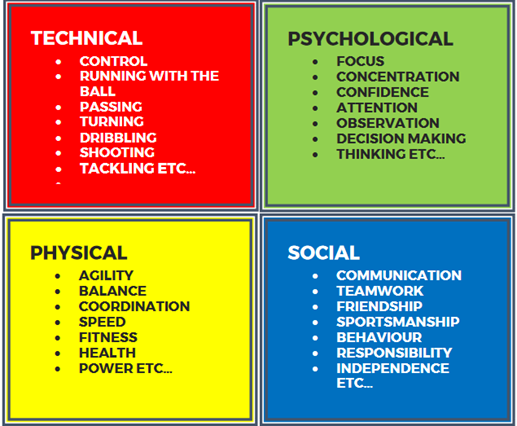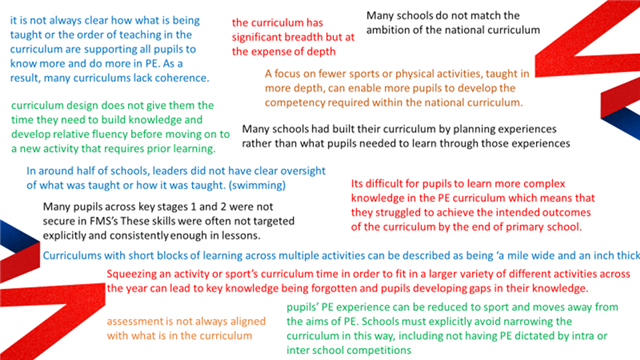Primary PE and Football - What can we learn from the recent Ofsted PE Subject Reports?
Written by: Chris Brammall, FA PE Officer
Questions we will frame this article around,
Q1 – What skills do we need to play the game of football?
Q2 – What key messages can we draw directly from the Ofsted reports regarding PE curricula?
Q3 – What might we Stop doing or Start doing to align with Ofsted’s key findings
It has been a decade since Ofsted last produced a PE subject report - Beyond 2012 : outstanding physical education for all (https://www.gov.uk/government/publications/beyond-2012-outstanding-physical-education-for-all) so the latest reports published in March 2022 and September 2023 have been welcomed by the PE & School Sport fraternity. The decade has witnessed many changes in the sector including a new PE national curriculum, the introduction of the PE & School Sport Premium funding, the launch of professional development qualifications for Primary PE subject leads, PE specialism opportunities for those in ITE & the funding of School Games Organisers to provide local support, CPD, competitions and festivals for schools.
Before we dive into the latest reports – PE Research Review (March 2022) and Levelling the Playing Field (September 2023) we will first consider the context of Primary PE and look to identify links between it and the game of football but also think about what football might look like and how it might support and contribute to high quality Physical Education at Key Stage 1 & 2.
To do this we will use the first question posed in the introduction – What skills do we need to play the game of football? The temptation here is to dive straight into the technical or ball skills needed such as dribbling, passing, ball control. Despite the obvious need to develop these ball mastery skills, our FA 4 Corner Model signifies the importance of developing the other equally relevant and important skills needed to play the beautiful game – Social, Psychological, and Physical:

This is where we will now consider the National Curriculum for PE at Key Stages 1 & 2 and look for how these align to the statutory minimum requirements to be taught in school curriculum lessons. In doing so we will not focus on other statutory areas of the curriculum that we still feel are as important but perhaps fall outside of our remit here as the National Governing Body for Football, i.e. Dance, Outdoor Adventurous Activities and Swimming.
Key Stage 1:
Pupils should be taught to:
- master basic movements including running, jumping, throwing and catching, as well as developing balance, agility and co-ordination, and begin to apply these in a range of activities
- participate in team games, developing simple tactics for attacking and defending
Key Stage 2:
Pupils should be taught to:
- use running, jumping, throwing and catching in isolation and in combination
- play competitive games, modified where appropriate and apply basic principles suitable for attacking and defending
- develop flexibility, strength, technique, control and balance
In addition to these bullet points, the National Curriculum identifies fairness & respect, communicating, collaborating and competing as attainment targets pupils should know, understand and be able to apply.
At both Key Stage 1 & 2 then, it is clear, the skills that should be explicitly taught and built into our schemes of work in curriculum PE reflect an holistic approach and align to the skills you need to be able to play the game of football. The key then is interpreting this into age and stage appropriate games and activities that will switch pupils on and not off to a lifelong love of physical activity, sport and physical education. We should not be looking to recreate what we might see on Match of the Day or Monday Night Football as this elite end of the game is far removed from what we might see and do in PE for a 5, 8 or 11 year old pupil. However, the fundamental building blocks that pupils will need to go on and participate in most forms of activity or sport, including football are what we should prioritise. We believe that high quality physical education = a high-quality introduction to the game of football. If the National Curriculum for PE is planned and taught well, whether football is used as the vehicle to deliver or not, then PE is an important ally for the game.
Having provided some context to the headline, we will now move onto the specific findings and key messages that for us stood out from Ofsted’s two reports, i.e. the second question we posed. Across both reports, there are many areas to consider, reflect upon and perhaps action for PE subject leaders in Primary School. For the purposes of this piece however, we are shining a light on all things PE curriculum that emerged rather than trying a catch all approach. To appraise all the aspects and themes from both reports would require more air time and a word limit beyond the scope of this blog. We have pulled together a range of statements drawn directly from the reports, i.e. Ofsted’s words, not ours, to highlight what we might be able to learn and consider in our practice when planning schemes of work or year group specific long-term plans;

Ofsted have been direct and candid with their language and terminology here perhaps alerting us to the need for change and evolution of PE curricula. Some observers might say the PE academics have been saying similar for over twenty years now (Kirk, Thorburn, Jess, Atencio) but without being able to change the status quo as much as they might like. Perhaps now the School Inspectorate is holding similar ground we might start to see some meaningful and positive developments to what PE is, looks like and feels like.
And to the final question posed in the introduction, what might we start doing or stop doing as a result?
|
Start |
Stop |
|
Being learning led |
Being sport/activity led |
|
Delivering the National Curriculum PE |
Being disconnected from the National Curriculum |
|
Aligning to our schools aims and purpose of PE |
Being sports and performance related |
|
Focusing on Fundamental Movement Skills mastery |
Missing these vital building blocks out that unlock much of the rest of the PE curriculum for pupils |
|
Developing holistic skills – 4 corner model |
Focusing only on a technique-based curriculum |
|
Spending longer on what we are learning (termly) |
Changing the activity or sport every half term |
|
Ensuring we have a joined up, sequenced and coherent PE curriculum |
Simply filling PE curriculum maps with lists of sports |
|
Switching pupils on to a love of PE & physical activity |
Planning and delivering just the traditional sports that half your class might be dreading |
|
Being inclusive to all abilities & gender |
Favouring the sporty few and boys |
|
To realise that teaching agility in a game of tag in a Year 2 lesson or teaching attacking and defending skills in a game of 4v4 benchball in a Year 4 lesson are teaching football skills without playing football |
Just teaching week 1 – passing, week 2 – dribbling, week 3 – ball control, week 4 – crossing, week 5 – scoring, week 6 - mini football festival. |
As a concluding thought, I would ask you to dive into these two reports in greater depth as this blog is intended as an appetiser to leave you hungry for more detail and information. As a member of the PE team at the FA, I was encouraged and excited by much of the findings shared by Ofsted which aligns to our teams thinking and approach. If you are a qualified Primary School Teacher and would like to learn more, then I would encourage you to attend one of our PE CPD for Teachers Awards which my colleagues and I deliver around the country.
Resources
https://www.gov.uk/government/publications/research-review-series-pe/research-review-series-pe

